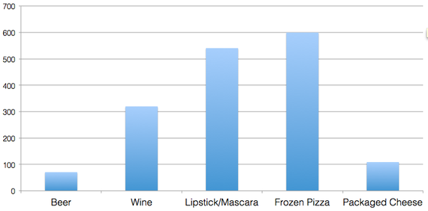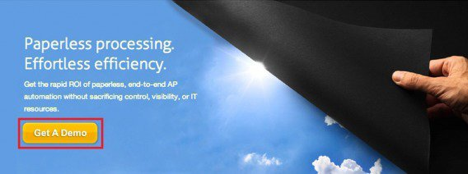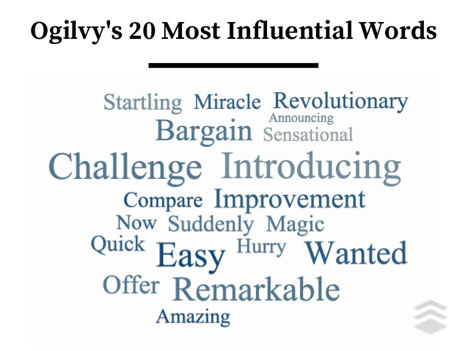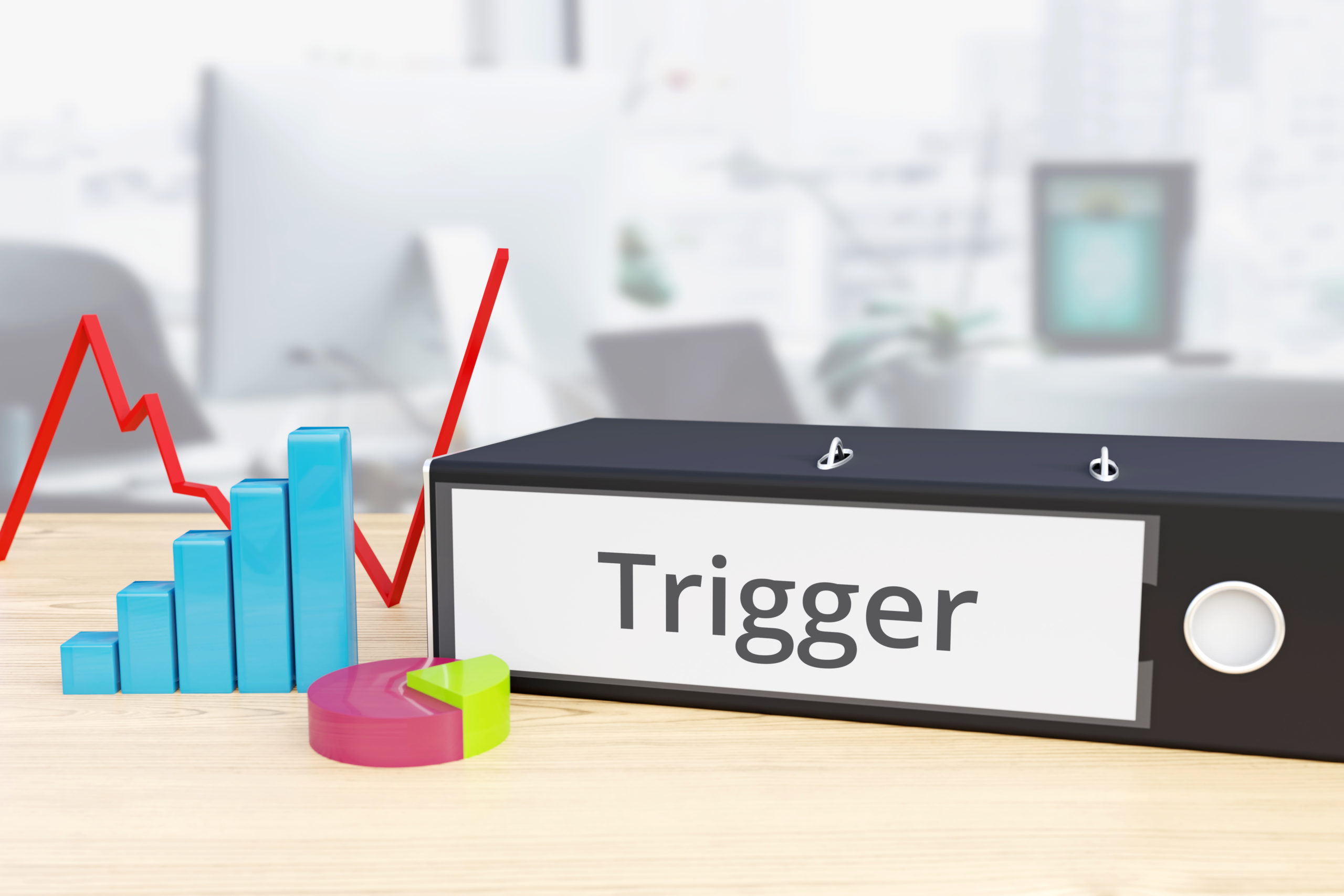The old adage “Sticks and stones may break my bones, but words will never hurt me” may be a convalescing defense for kids at school, but it’s hardly accurate.
Words can inflict pain, damage self-esteem. Words can inspire, change minds, and increase compassion.
The ability of words to affect our actions and emotions has been well documented and backed by research. For example, “scientists have found that just hearing sentences about elderly people led research subjects to walk more slowly.”
Words are powerful.
And from a marketing standpoint, the right words can make all the difference when it comes to getting people to take notice and take action.
Of course, the merit of your content or offer is what ultimately matters most. But the words you choose to showcase the benefits and value of what you’re offering play a crucial role in determining the degree to which people are compelled to move forward—whether it’s to click, sign-up, share, or purchase—and a single word can be more influential than you might think.
Kevan Lee from BufferApp shares the following insight:
 Kevan Lee: “I subscribe to the copywriting school of thought where every single word is absolutely worth stewing over and A/B testing because one single word can change everything.
Kevan Lee: “I subscribe to the copywriting school of thought where every single word is absolutely worth stewing over and A/B testing because one single word can change everything.
The different between ‘joining’ and ‘signing up’ is the difference between fellowship and enlisting. A word changes the meaning, the mood, and the motivation.”
With that being the case, which words are more likely to provide marketers with a linguistic leg up? Which words produce higher conversion rates?
The Most Effective Words In The English Language
According to Gregory Ciotti from Copyblogger, the five most persuasive English words are you, because, instantly, new, and free.
And while you may be thinking that these alleged “power words” don’t seem all that commanding, given their commonplace usage, don’t underestimate them. Concise, simple language is highly effective at persuading and directing people.
In fact, most leading publications, including the New York Times and the Economist, are written at middle school levels to enhance readability and comprehension.

There is one caveat, however.
Ciotti stresses that when using this list of words in your copy, “you must understand why these words are persuasive, and you must use them in the contexts that make sense for your audience and your business. If you just start slapping them on every piece of content you create for no apparent reason, you’ll quickly see just how unpersuasive they can be.”
That being said, here is the information you need to comprehend Ciotti’s why factor:
You
“You” is often cited at the top of lists regarding persuasive language thanks to a study conducted by Yale University in 1970 (although a lack of citations or any researchers coming forward to claim authorship indicates that this study likely never happened).
Nevertheless, copywriters still find that “you” retains high levels of persuasiveness, as it invokes the power of the self—a power that is exercised even more effectively when a person’s name is used.
Researchers Dennis P. Carmody and Michael Lewis found that hearing one’s own first name produces “unique brain functioning activation” when compared to hearing the names of other people, which makes sense. Self-recognition and identity formation are important facets of being human, and a person’s name is closely tied to those things so it’s unsurprising that people become more engaged when their names are involved.
“Remember that a person’s name is to that person the sweetest and most important sound in any language.” – Dale Carnegie
Personalization is especially beneficial during the follow-up of a purchase or other transaction, as it allows customers to feel like doing business with you was the right choice and consequently establishes trust and helps build relationships.

Of course, using a person’s name is not always feasible, but any aspect of copywriting that capitalizes on permission marketing, such as email campaigns and newsletters, can profit from adding a personal touch.
Because
“Because” is one of those deceptively ordinary words that has near-magical properties in terms of influencing behavior. Research shows that if you want to get people to do something, simply give them a reason—even a lame one will do the trick—as using the word “because” is like the linguistic equivalent of waving a magic wand.
Huffington Post writer Melissa Dahl reports on a classic 1970s “mindless behavior” study conducted by behavioral scientist Ellen Langer to demonstrate the power of reasoning:
 Melissa Dahl: “Langer’s famous study began when there was a line of people waiting to use a photocopier. Then she tried cutting in line. She wasn’t rude about it, though. She asked politely, “Excuse me, I have five pages. May I use the Xerox machine?” Over and over she tried this and found that 60 percent of the people allowed her to go ahead of them.
Melissa Dahl: “Langer’s famous study began when there was a line of people waiting to use a photocopier. Then she tried cutting in line. She wasn’t rude about it, though. She asked politely, “Excuse me, I have five pages. May I use the Xerox machine?” Over and over she tried this and found that 60 percent of the people allowed her to go ahead of them.
Then Langer got more specific. “Excuse me, I have five pages. May I use the Xerox machine because I’m in a rush?” When she gave a reason, the rate of compliance shot up to 94 percent. No real surprise there.
The surprise comes with the third question: “Excuse me, I have five pages. May I use the Xerox machine because I have to make some copies?” The rate of compliance stayed about the same, at 93 percent, even though she removed the reason.”
Langer goes from having a barely passable reason (“I’m in a rush”) to having no reason at all (“I have to make some copies”) but using the word “because” still satisfies the majority of people in line and they allow her to cut.
Now, while even weak or flimsy reasons retain the ability to persuade, the importance of a request should be proportional to the cogency of the reason—that is, the bigger the request, the better the reason need to be.
When writing persuasive copy, you need to hone in on your customers’ number one concern: “What’s in it for me?”
Highlight the most captivating benefits and features of your offer, providing your customers with the strongest possible incentive to take action, and use “because” as the gateway to these reasons—but as with most things, moderation is key.
Instantly
Considering the vast amount of information, software, and connections that are available to us at the click of a button, it’s no wonder that we want things now, now, now.
Delayed gratification may be an important skill to develop, as evinced in research such as the Stanford Marshmallow Experiment, leading to the activation of our brains’ frontal cortex. But in terms of sales and marketing, it’s all about the mid-brain, and “several MRI studies have shown just how fired up our mid-brain gets when we envision instant rewards.”
For those in the business of vending information or software, “instant access” is completely feasible. For those selling physical goods or services, however, endorsing guarantees like speedy deliveries or contacting customers within 24 hours still can be highly effective at swaying customers to take action.
Just remember to…
“Always deliver on your promises. And, whenever possible, over-deliver.” – Gregory Ciotti
It’s much better to under-promise and over-deliver, and pleasantly surprise your customers than it is to fall short of your guarantee and incite their wrath.
New
There are two sides to the word “new.” On one hand, we don’t like change and respond more positively to familiar brands. But at the same time, our “sense of adventure” leads us to gravitate towards novelty items. Scientists discovered that “people are programmed to try out something new, such as a familiar product in an unfamiliar package or one that boasts a new formula.”
And the “newness” or innovation element is important especially for physical products because physical products don’t age as well as “experiential purchases,” such as a vacation package or concert tickets.
For example, the value of that brand new laptop you just bought is going to depreciate over the course of a few years as updates and newer technologies become available whereas the value of the cruise you took last spring is likely to be remembered even more fondly as time goes on.
Given the dual nature of the word “new,” how can you then strike a balance in your copywriting?
 Gregory Ciotti: “The important things to consider here are which parts of your business generate trust, and which parts generate utility. It’s your brand that creates trust, and as the saying goes, if it ain’t broke, don’t fix it.
Gregory Ciotti: “The important things to consider here are which parts of your business generate trust, and which parts generate utility. It’s your brand that creates trust, and as the saying goes, if it ain’t broke, don’t fix it.
Your products, however, are what customers get utility out of, and stagnant offerings are your first-class ticket to an abysmally bored userbase.
Your core brand elements like your unique selling proposition, your dazzling customer service and your quality offering in the marketplace should be approached with excessive caution if things are going well.”
Therefore, “newness” is best instilled with new features, design improvements, or new solutions to old problems. You want to excite customers with new innovations while maintaining their trust in you as a high quality, reputable brand.
Free
“Free” is another one of those words that’s incredibly powerful in some cases, but in others, it can actually hurt (we’ll get to that a little further down).
Freebies are often great and people usually love them. Free samples. Free shipping. Free trials. I have a friend who loves to say, “If it’s free, take two!”
And the power of “free” has been well-documented. In his book Predictably Irrational behavioral economist Dan Ariely describes two noteworthy studies: one involving gift cards, the other involving chocolate.
In the first study, a group of people was given two options: a $10 Amazon gift card for free or a $20 gift card for $7. The study found that even though the $7 gift card provided more value, more people selected the free option.
In the second study, people had to choose between a $.01 Hershey Kiss and a $.15 Lindt Truffle, which generally retails for closer to $.40 and is considered richer, higher quality chocolate. Seventy-three percent of people chose the Lindt Truffle compared to twenty-seven percent who chose the Hershey Kiss.
Then, in a follow-up, another group of participants was once again asked to choose between a Hershey Kiss and a Lindt Truffle. This time, however, the price of each chocolate was reduced by $.01, meaning the Lindt Truffle now cost $.14 and the Hersey Kiss was free.
In this case, the results flip-flopped: 69% of people chose the Hersey Kiss and only 31% opted for the Lindt Truffle, even though the difference in price—14 cents—remained the same.
According to Ariely, this shift in opinion points to our tendency to prefer “avoiding losses to acquiring gains” (loss aversion) as well as our “natural instinct to go after ‘low hanging fruit’” to explain why we are more inclined to choose the freebie.
When “Free” Works: Shipping, Samples, and Websites
As evinced above, people gravitate towards the free option regardless of its inherent value.
In the case of shipping charges, Chris Anderson describes in his book Free how Amazon’s sales increased in every country except for France once it started its free shipping offer, with the discrepancy being that France offered shipping for $.20.
So even though $.20 is basically free, that small charge was enough to deter customers. And once France switched and started offering free shipping, its sales increased as well.
The power of the free shipping threshold has been documented in other case studies as well, and generally speaking, free shipping works more often than not when it comes to A/B tests.
Similarly, free samples have been shown to positively affect a company’s bottom line as well as influence customers’ buying behavior, inciting them to make purchases they wouldn’t normally make.
Last year, Interactions, the product-demonstration company that handles Costco’s free samples, saw a 71% increase in their beer sales and a whopping 600% increase in their frozen pizza sales thanks to sampling.
Below, you can see a chart from the Atlantic showing the “average percentage increase in sales after product samples in the past year, by product type”:

Free samples benefit businesses in a number of ways. They make the shopping experience more enjoyable and help customers learn about new products. Plus, they increase brand loyalty over time, and according to Dan Ariely, free samples trigger the reciprocity instinct: “If somebody does something for you, you really feel a rather surprisingly strong obligation to do something back for them.”
But what about websites and copywriting? How does “free” affect conversions in those realms?
In one case study, Corcentric, a financial process automation software company, tested the copy of the yellow CTA button on its homepage. Originally, the text read: “Get a Demo.”

Then, the copy was changed to read “Free Demo” to assess whether the word “free” would entice more visitors to click the button.

After running the A/B for two weeks on almost 800 visitors, the “free” version emerged as the clear victor, recording a 99.42% increase in the button’s click-through rate.
Taruna from VWO.com cites several other case studies in which the word “free” significantly boosted conversions:
GetResponse: Trial signups increased by 158% once the “Free Trial” button was added next to the “Buy Now” button.
Billund Airport: Click-through rates increased by 49.58% after changing the CTA copy from “Shop Online” to “Buy Tax-Free.”
Soocial: Conversion rates increased by 28% when “It’s free” was added next to the CTA button.
In terms of conversion optimization, there is much anecdotal support for using the word “free”. However, the power of “free” should be taken with a grain of salt, as not all of the aforementioned case studies comment on the statistical validity of their tests. Plus, case studies have also been done in which “free” has been shown to actually hurt conversions.
When “Free” Hurts: Emails and Bargain Hunters
“Free” can be especially tricky when used with emails. “Open now to get your free report!” may be an enticing subject line, but “free” is often treated as a spam filter red flag that will get your messages sent to email no-man’s-land: the dreaded spam folder. And not having your emails make it to their intended recipients isn’t a risk you should take.
Susan Gunelius from Entrepreneur makes the following suggestion for what to say instead: “Replace ‘free’ with ‘complimentary’ or ‘gratis’ to sneak by spam filters without compromising the effectiveness of your message.”
Additionally, while offering something for free frequently attracts more people, a number of those customers are going to be “bargain hunters” who are unlikely to turn into the type of long-term buyer you need to grow your business.
Robert Dooley from Neuromarketing explains that “if you are trying to encourage sampling of a product that appeals to a specific audience…a very modest charge will throttle demand but will eliminate most samplers who have no use for the product.”
He cites the following example:
 Roger Dooley: “I don’t own a cat. I don’t even care much for cats. But if the supermarket had a big display of ‘Free Cat Food Samples’ there’s a good chance that I’d pick one up, thinking that I’d give it to a friend. Or maybe hang onto it for when one of the inevitable stray cats show up.
Roger Dooley: “I don’t own a cat. I don’t even care much for cats. But if the supermarket had a big display of ‘Free Cat Food Samples’ there’s a good chance that I’d pick one up, thinking that I’d give it to a friend. Or maybe hang onto it for when one of the inevitable stray cats show up.
Hey, it’s FREE – I’ll grab it now and figure out what to do with it later.”
If, however, the supermarket charged a meager $.10 for the cat food sample, most of the incongruous sampling from “bargain hunters” would be eliminated. Some legitimate cat owners may also be swayed from trying the sample, but the overall effectiveness of the program to attract more long-term buyers for the company’s flagship products would likely improve.
Therefore, you should “use free only when it makes sense, and only in the right context.”
More Power Words To Increase Conversions
You, because, instantly, new, and free aren’t the only words that possess the ability to persuade. In 1963, advertising icon David Ogilvy compiled the following list of power words, most of which are still widely agreed upon today.

Similarly, Kevan Lee from BufferApp has compiled several lists of power words best used in specific areas of copywriting, including the following:
Email Signups and Trial Offers: 3 Words that Encourage Community
- Become a member
- Join
- Come along
Calls-To-Action: 5 Words That Suggest Exclusivity
- Members Only
- Login required
- Class full
- Become an insider
- Only available to subscribers
Payment or Sign-Up Forms: 10 Words That Denote Safety
- Backed
- Best-selling
- Cancel anytime
- Guaranteed
- Money-back
- No questions asked
- Official
- Refund
- Secure
- No strings attached
Promo Copy: 5 Words That Imply Scarcity
- Sale ends soon
- Today only
- Only X amount available
- Get them while they last
- Supplies running out
Social Media Updates: 9 Words That Promote Sharing
- Secret
- Tell us
- Promote
- Create
- Discover
- Inspires
- Take
- Help
- Increase
Conclusion
Words are the most powerful tool in a copywriter’s arsenal. The right words can evoke particular emotions or trigger specific responses in people. Therefore, whether it’s the language used in an email, sales letter, or CTA, or the text displayed on a button or sign-up form, words play an important role when it comes to conversion rates and they absolutely should be A/B tested.
In addition to the power words detailed above, pay attention to the words and phrases you’re drawn to as you’re browsing online. Which headlines stand out? Which words pique your attention and get you to click or read more?
Build your own list of power words in a note-taking app such as Evernote so you’ve got a word toolbox that’s ready to go whenever you need to pack some punch into your copy.
Have something to add? Leave us a comment below now.
Be sure to like, share and subscribe so you never miss an update.
If you want help testing some influential and persuasive trigger words to help boost your conversions, reach out for a no-obligation conversion acceleration session.




